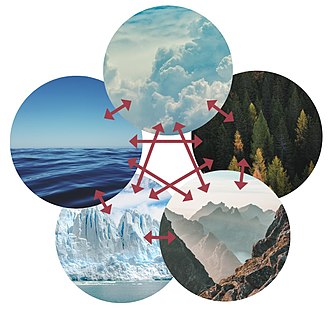
Back نظام مناخي Arabic জলবায়ু ব্যবস্থা Bengali/Bangla Sistema climàtic Catalan Klimatický systém Czech Κλιματικό σύστημα Greek Sistema climático Spanish سامانه اقلیمی زمین Persian Système climatique French Sistem iklim ID 기후계 Korean

Earth's climate system is a complex system with five interacting components: the atmosphere (air), the hydrosphere (water), the cryosphere (ice and permafrost), the lithosphere (earth's upper rocky layer) and the biosphere (living things).[1] Climate is the statistical characterization of the climate system.[2] It represents the average weather, typically over a period of 30 years, and is determined by a combination of processes, such as ocean currents and wind patterns.[3][4] Circulation in the atmosphere and oceans transports heat from the tropical regions to regions that receive less energy from the Sun. Solar radiation is the main driving force for this circulation. The water cycle also moves energy throughout the climate system. In addition, certain chemical elements are constantly moving between the components of the climate system. Two examples for these biochemical cycles are the carbon and nitrogen cycles.
The climate system can change due to internal variability and external forcings. These external forcings can be natural, such as variations in solar intensity and volcanic eruptions, or caused by humans. Accumulation of greenhouse gases in the atmosphere, mainly being emitted by people burning fossil fuels, is causing climate change. Human activity also releases cooling aerosols, but their net effect is far less than that of greenhouse gases.[1] Changes can be amplified by feedback processes in the different climate system components.
- ^ a b c Planton 2013, p. 1451.
- ^ Planton 2013, p. 1450.
- ^ "Climate systems". climatechange.environment.nsw.gov.au. Archived from the original on 2019-05-06. Retrieved 2019-05-06.
- ^ "Earth's climate system". World Ocean Review. Retrieved 2019-10-13.
© MMXXIII Rich X Search. We shall prevail. All rights reserved. Rich X Search